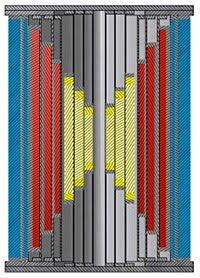
Cross-sectional diagram of the planned 32-tesla superconducting magnet. The magnet will consist of three YBCO coils (yellow), three niobium-tin coils (red) and two niobium-titanium coils (blue).
A magnet, funded by a National Science Foundation grant of $2 million and a matching award from The Florida State University of $1 million, is projected to generate a magnetic field of 32 tesla. (Tesla is the scientific unit of measure of magnetic field strength.) That is more than 3,000 times stronger than a typical refrigerator magnet, and about 45 percent more powerful than the strongest superconducting magnets available today.
Field strength: 32 tesla
Bore size: 34 mm
Cost: $3 million
Expected completion: Fall 2012
YBCO cable: About 5 miles (8 km)
Field uniformity: 5×10^-4 1 cm
It should be high quality magnet like the lab’s world-record 900 megahertz, ultra-wide-bore superconducting magnet.
How does this relate to the work of the UK company Magnifye ? Magnifye main breakthrough seems to be a new and cheaper way to charge superconducting magnets using a heat engine instead of a more powerful magnet than the target Tesla field. Magnifye method should be compatible with these magnets to enable cheaper initial charging.
This work is parallel with work on BSCCO superconducting magnets of comparable field strength. Although BSCCO material can superconduct at temperatures that are comparable to YCBO. The high field BSCCO needs to be cooled to lower temperatures.
Applications:
* Better quantum oscillation measurements
* Hopefully advanced the understanding of superconductivity physics
* Should lead to even better superconducting magnets and hopefully breakthroughs in understanding that lead to room temperature superconductors.
* It will allow more detailed investigation of other superconducting materials
* It will provide low cost permanent high field magnets instead of pulsing to this field strength or using resistive magnets that are expensive to get up to high field strength
“This magnet opens up new possibilities for measurements that we have previously only dreamed of,” Julian said. “With these new magnets, researchers will be able to stay at these very high magnetic fields for as long as they like. This will dramatically increase the quality of data for many measurements. We can look forward to breakthroughs in biomedical magnetic resonance imaging, studies of protein structure, semiconductor physics and the physics of metals.”
Perhaps most fittingly, this new magnet will advance research on the high-temperature superconductors themselves, a primary interest of David Larbalestier, chief materials scientist at the lab and the other co-principal investigator on the grant.
“We’re going to be using high temperature superconductors to understand high temperature superconductors, and that seems quite fun,” Julian said.

A Prototype superconducting magnet being lowered into a cryostat in 2008

Brian Wang is a Futurist Thought Leader and a popular Science blogger with 1 million readers per month. His blog Nextbigfuture.com is ranked #1 Science News Blog. It covers many disruptive technology and trends including Space, Robotics, Artificial Intelligence, Medicine, Anti-aging Biotechnology, and Nanotechnology.
Known for identifying cutting edge technologies, he is currently a Co-Founder of a startup and fundraiser for high potential early-stage companies. He is the Head of Research for Allocations for deep technology investments and an Angel Investor at Space Angels.
A frequent speaker at corporations, he has been a TEDx speaker, a Singularity University speaker and guest at numerous interviews for radio and podcasts. He is open to public speaking and advising engagements.

